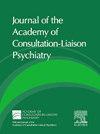Frailty and Its Association With Catatonia in the Intensive Care Unit: An Analysis of the Delirium and Catatonia Prospective Cohort Study
IF 2.5
4区 心理学
Q2 PSYCHIATRY
Journal of the Academy of Consultation-Liaison Psychiatry
Pub Date : 2025-09-01
DOI:10.1016/j.jaclp.2025.06.010
引用次数: 0
Abstract
Background
Frailty is a syndrome characterized by the loss of physiologic reserve and is predictive of subsequent cognitive impairment, disability, and mortality. Catatonia is an underrecognized form of acute brain dysfunction in critical illness.
Objective
To describe association between baseline frailty and catatonia development in the context of critical illness.
Methods
This is a prospective cohort of critically ill adults from a single academic medical center. We included those assessed for pre-existing frailty within 72 hours of study enrollment using the Clinical Frailty Scale. Patients with moderate to severe cognitive impairment at baseline were excluded. Participants were assessed for catatonia using the Bush-Francis Catatonia Rating Scale mapped to Diagnostic and Statistical Manual of Mental Disorders, 5th edition criteria, within the first 14 days of critical illness. To examine the association between baseline frailty and catatonia, we used a chi-square test to evaluate trends in proportions performed for catatonia. To describe measures of association between frailty state along the fitness-frailty continuum and presence of catatonia, we used logistic regression, adjusting for cofounders of interest.
Results
Of 170 patients with a median age of 62 years, 47 (28%) were considered frail and 49 (29%) developed catatonia. In a logistic regression model, frailty was not significantly associated with catatonia presence or absence in the Intensive Care Unit (ICU) (odds ratio = 1.064 [95% confidence interval: 0.805, 1.405], P = 0.664].
Conclusions
Our study did not demonstrate an independent association with increasing levels of frailty along a fitness-frailty continuum and the presence of catatonia. More research is needed to determine if pre-existing frailty may be a predisposing factor for catatonia in the setting of critical illness.
重症监护室虚弱及其与紧张症的关系:谵妄和紧张症前瞻性队列研究分析。
简介:虚弱是一种以生理储备丧失为特征的综合征,预示着随后的认知障碍、残疾和死亡。紧张症是危重疾病中急性脑功能障碍的一种未被认识的形式。基线虚弱和紧张症发展之间的联系以前没有被描述过。方法和材料:这是一项来自单一学术医疗中心的危重成人前瞻性队列研究。我们纳入了在研究入组后72小时内使用临床虚弱量表评估既往虚弱的患者。排除基线时有中度至重度认知障碍的患者。在危重疾病的头14天内,使用Bush Francis紧张症评定量表对参与者进行紧张症评估,该量表与精神疾病诊断与统计手册第5版标准相对应。为了检验基线虚弱和紧张症之间的关系,我们使用卡方检验来评估紧张症的比例趋势。为了描述虚弱状态与紧张症之间的关联,我们使用了逻辑回归,调整了共同创始人的兴趣。结果:在170例中位年龄62岁的患者中,47例(28%)虚弱,49例(29%)出现紧张症。在logistic回归模型中,虚弱与ICU中存在或不存在紧张症无显著相关性(or = 1.064 [95% CI: 0.805, 1.405], p = 0.664]。结论:我们的研究并没有证明在健康-虚弱连续体中虚弱程度的增加和紧张症的存在之间存在独立的联系。需要更多的研究来确定先前存在的虚弱是否可能是危重疾病环境中紧张症的诱发因素。
本文章由计算机程序翻译,如有差异,请以英文原文为准。
求助全文
约1分钟内获得全文
求助全文
来源期刊

Journal of the Academy of Consultation-Liaison Psychiatry
Psychology-Clinical Psychology
CiteScore
5.80
自引率
13.00%
发文量
378
审稿时长
50 days
 求助内容:
求助内容: 应助结果提醒方式:
应助结果提醒方式:


